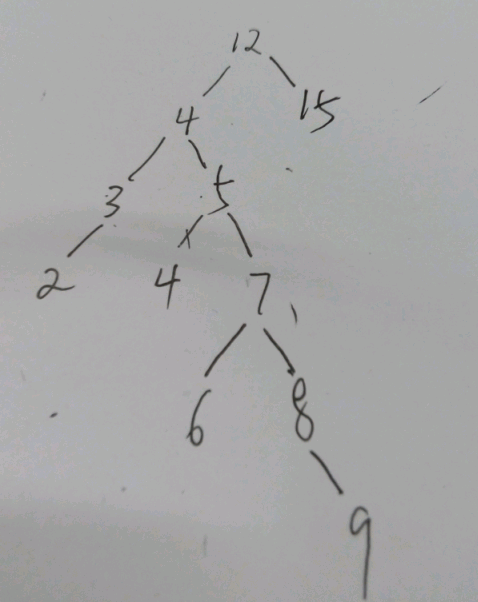二叉搜索树的Java实现
为了更加深入了解二叉搜索树,博主自己用Java写了个二叉搜索树,有兴趣的同学可以一起探讨探讨。
首先,二叉搜索树是啥?它有什么用呢?
二叉搜索树, 也称二叉排序树,它的每个节点的数据结构为1个父节点指针,1个左孩子指针,1个有孩子指针,还有就是自己的数据部分了,因为只有左右两孩子,所以才叫二叉树,在此基础上,该二叉树还满足另外一个条件:每个结点的左孩子都不大于该结点&&每个结点的右孩子都大于该结点。这样,我们队这棵树进行中序遍历,就能把key从小到大排序了……
那么问题来了,我都有线性表有链表了,我还要它干啥?两个字! 效率 !
相比线性表,你要搜索一个key,就要执行一次线性时间,算法复杂度为O(n);而用二叉搜索树,算法效率是O(lgn)!这是很诱人的数字。下面我用Java实现以下二叉搜索树,你自然就明白为什么算法复杂度是O(lgn)了。
其次,写一个数据结构,自然而然也要实现对这个数据结构的增、删、查、改了。
下面是我的思路:
- 创建树:我是通过一个一个结点的插入来建立一棵二叉搜索树。
- 搜索结点:从根节点开始,进行key的比较,小了就往左走,大了就往右走,最后到了叶子结点都还没有的话,那么该树就不存在要搜索的结点了。
- 修改结点:修改其实就是查询,在查询之后把结点的数据部分给改了而已,这里我就不重复去实现了。
- 删除结点:这个应该就是最难的了,所以我有必要详细讲,先上图(不好意思,懒得用软件画图了,将就将就下哈):

当我们要删除一个结点时,分如下几种情况:
- 此结点是叶子结点,这个最简单啦,直接把结点给释放掉就行了。(如图删除9)
- 此结点只有左孩子,这个也简单啦,直接把左子树替换过来就行了。(如图删除3)
- 此结点只有右孩子,同上。(如图删除8)
- 此结点有左右孩子,当出现这种情况时(如图删除7),我们就要找出该结点的 后继结点 (因为右子树肯定存在,所以找肯定在右子树中),然后把这个后继结点替换到要删除的结点中,然后继续执行对这个后继结点的删除操作(递归删除操作就行了)。
发现没?现在我的解题思路是自顶向下去分析…… 自顶向下,逐级求精 是一个很伟大的思想!
现在问题来了! 后继结点 怎么求?我们来分析一下,当求一个结点的后继结点时,分为以下两种情况:
- 当该结点有右孩子时,后继结点就在右子树中,就是该右子树的 最小结点
- 当该结点没有右孩子时,那后继结点就满足这个条件:该后继结点是该结点的祖先&&该结点位于该结点的左子树中(如图中的9的后继结点是12)
哎呀呀!问题又来了! 最小结点 咋办!很简单!
当求一棵树的最小结点时,那么就要从这颗树的根节点开始,一直往左子树走,就能找到它的最小结点了!
好了,现在问题逐步解决了!删除结点的功能也就完成了!
最后, 没代码说个锤子 ,咱上代码!
首先,写个测试类:

1 public class Test { 2 public static void main(String[] args) { 3 int[] datas={12,4,5,7,4,8,3,2,6,9}; 4 BinTree tree=new BinTree(datas); 5 tree.preOrderTraverse();//先序遍历 6 tree.midOrderTraverse();//中序遍历 7 tree.postOrderTraverse();//后序遍历 8 tree.insert(15); //插入结点 9 tree.search(7); //查询结点 10 tree.search(100); //查询一个不存在的结点 11 tree.getMax(); //获取最大值 12 tree.getMin(); //获取最小值 13 tree.getPre(7); //前驱结点 14 tree.getPre(2); //最前的前驱结点 15 tree.getPost(7); //后继结点 16 tree.getPost(15); //最后的后继结点 17 tree.delete(5); //删除结点 18 tree.delete(0); //删除一个不存在的结点 19 } 20 }View Code
然后,二叉搜索树:
1 public class BinTree { 2 Node root=null; 3 private class Node{ 4 Node parent=null; 5 Node leftChild=null; 6 Node rightChild=null; 7 int key; 8 public Node(int data) { 9 this.key=data; 10 } 11 } 12 public BinTree(int[] datas) { 13 buildTree(datas); 14 } 15 private void buildTree(int[] datas) { 16 for (int i = 0; i < datas.length; i++) { 17 Node node=new Node(datas[i]); 18 insertNode(node); 19 } 20 } 21 private void insertNode(Node node) { //插入结点 22 Node next=this.root; 23 Node cur=null; //用来保存当前结点 24 while(next!=null){ //当到达叶子结点时,确认位置! 25 cur=next; 26 if(node.key>=cur.key){ 27 next=next.rightChild; 28 }else{ 29 next=next.leftChild; 30 } 31 } 32 node.parent=cur; //插入该结点! 33 if(cur==null){ 34 this.root=node; //该树为空树,所以这个是根节点 35 }else if(node.key>=cur.key){ 36 cur.rightChild=node; 37 }else{ 38 cur.leftChild=node; 39 } 40 } 41 /* 42 * 插入一个数 43 */ 44 public void insert(int data){ 45 Node node=new Node(data); 46 System.out.println("插入结点:"+data); 47 insertNode(node); 48 this.midOrderTraverse(); 49 } 50 51 /* 52 * 先序遍历 53 */ 54 public void preOrderTraverse(){ 55 System.out.println("先序遍历:"); 56 preOrderTraverse(root); 57 System.out.println(); 58 } 59 private void preOrderTraverse(Node node){ //先序遍历 60 if(node!=null){ 61 System.out.print("-"+node.key+"-"); 62 preOrderTraverse(node.leftChild); 63 preOrderTraverse(node.rightChild); 64 } 65 } 66 /* 67 * 中序遍历 68 */ 69 public void midOrderTraverse(){ 70 System.out.println("中序遍历:"); 71 midOrderTraverse(root); 72 System.out.println(); 73 } 74 private void midOrderTraverse(Node node){ //中序遍历 75 if(node!=null){ 76 midOrderTraverse(node.leftChild); 77 System.out.print("-"+node.key+"-"); 78 midOrderTraverse(node.rightChild); 79 } 80 81 } 82 83 /* 84 * 后序遍历 85 */ 86 public void postOrderTraverse(){ 87 System.out.println("后序遍历:"); 88 postOrderTraverse(root); 89 System.out.println(); 90 } 91 private void postOrderTraverse(Node node){ //后序遍历 92 if(node!=null){ 93 System.out.print("-"+node.key+"-"); 94 postOrderTraverse(node.leftChild); 95 postOrderTraverse(node.rightChild); 96 } 97 } 98 99 /* 100 * 搜索结点 101 */ 102 public void search(int data){ 103 System.out.println("您要查找的是:"+data); 104 Node node; 105 if((node=searchNode(new Node(data)))==null){ 106 System.out.println("树中没有该结点!"); 107 }else{ 108 System.out.println("查找"+node.key+"成功!"); 109 } 110 } 111 112 private Node searchNode(Node node){ //private供内部调用,搜索结点 113 if(node==null){ 114 System.out.println("输入为空,查找失败!"); 115 }else{ 116 if(root==null){ 117 System.out.println("该树为空树!"); 118 }else{ //开始查找 119 boolean isFound=false; 120 Node x=root; 121 Node y=null; 122 while(!isFound&&x!=null){ //当查到或者到了叶子节点还没查到时,终结! 123 y=x; 124 if(node.key==x.key){ 125 isFound=true; 126 }else{ //通过比较大小往下面查找 127 if(node.key>x.key){ 128 x=x.rightChild; 129 }else{ 130 x=x.leftChild; 131 } 132 } 133 } 134 if(isFound){ //没找到的话,在最后返回null 135 return y; 136 } 137 } 138 } 139 return null; 140 } 141 142 /* 143 * 获取最大值 144 */ 145 public void getMax(){ 146 Node node; 147 if((node=getMaxNode(root))==null){ 148 System.out.println("该树为空!"); 149 }else{ 150 System.out.println("最大的结点是:"+node.key); 151 } 152 153 } 154 155 private Node getMaxNode(Node node){ //获取最大值 156 if(node!=null){ 157 Node x=node; 158 Node y=null; 159 while(x!=null){ //一直往右遍历直到底就是最大值了! 160 y=x; 161 x=x.rightChild; 162 } 163 return y; 164 } 165 return null; 166 } 167 168 /* 169 * 获取最小值 170 */ 171 public void getMin(){ 172 Node node; 173 if((node=getMinNode(root))==null){ 174 System.out.println("该树为空!"); 175 }else{ 176 System.out.println("最小的结点是:"+node.key); 177 } 178 } 179 private Node getMinNode(Node node){ //获取最小值 180 if(node!=null){ 181 Node x=node; 182 Node y=null; 183 while(x!=null){ //一直往左遍历直到底就是最小值了! 184 y=x; 185 x=x.leftChild; 186 } 187 return y; 188 } 189 return null; 190 } 191 192 /* 193 * 获取前驱结点 194 */ 195 public void getPre(int data){ 196 Node node=null; 197 System.out.println(data+"的前驱结点:"); 198 if((node=getPreNode(searchNode(new Node(data))))==null){ 199 System.out.println("该结点不存在或无前驱结点!"); 200 }else{ 201 System.out.println(data+"的前驱结点为:"+node.key); 202 } 203 } 204 205 private Node getPreNode(Node node){ //获取前驱结点 206 if(node==null){ 207 return null; 208 } 209 if(node.leftChild!=null){ //当有左孩子时,前驱结点就是左子树的最大值 210 return getMaxNode(node.leftChild); 211 }else{//当不存在左孩子时,前驱结点就是——它的祖先,而且,它在这个祖先的右子树中。这句话自己画图就能理解了 212 Node x=node; 213 Node y=node.parent; 214 while(y!=null&&x==y.leftChild){ 215 x=y; 216 y=y.parent; 217 } 218 return y; 219 } 220 } 221 222 /* 223 * 获取后继结点 224 */ 225 public void getPost(int data){ 226 Node node=null; 227 System.out.println(data+"的后继结点:"); 228 if((node=getPostNode(searchNode(new Node(data))))==null){ 229 System.out.println("该结点不存在或无后继结点!"); 230 }else{ 231 System.out.println(data+"的后继结点为:"+node.key); 232 } 233 } 234 235 private Node getPostNode(Node node){ //获取后继结点 236 if(node==null){ 237 return null; 238 } 239 if(node.rightChild!=null){ //当有右孩子时,前驱结点就是右子树的最小值 240 return getMinNode(node.rightChild); 241 }else{//当不存在右孩子时,后继结点就是——它的祖先,而且,它在这个祖先的左子树中。这句话自己画图就能理解了 242 Node x=node; 243 Node y=node.parent; 244 while(y!=null&&x==y.rightChild){ 245 x=y; 246 y=y.parent; 247 } 248 return y; 249 } 250 } 251 252 253 /* 254 * 删除结点 255 */ 256 public void delete(int data){ 257 Node node; 258 if((node=searchNode(new Node(data)))==null){//注意!这里不能new结点!你必须从树中找该结点!new就是初始化了 259 System.out.println("二叉树中不存在此结点!"); 260 return; 261 } 262 deleteNode(node); 263 System.out.println("删除结点"+data+"后:"); 264 this.midOrderTraverse(); 265 } 266 267 268 private void deleteNode(Node node){ 269 if(node==null){ 270 System.out.println("删除结点不能为空!"); 271 return; 272 } 273 replacedNode(node); 274 } 275 276 private void replacedNode(Node node) { //替换结点 277 if(node.leftChild!=null 278 &&node.rightChild!=null){ //当有左右孩子时,用后继结点替换 279 replacedNodeOfPost(node); 280 } 281 else 282 { 283 if(node.leftChild!=null){ //当只有左孩子时,直接用左子树替换 284 node=node.leftChild; 285 }else if(node.rightChild!=null){ //只有右孩子时,直接有子树替换 286 node=node.rightChild; 287 }else{ //当没有左右孩子时,就直接释放了这个结点 288 freeNode(node); 289 } 290 } 291 } 292 293 294 private void freeNode(Node node) { //释放该结点,断掉其与父结点的链接 295 if(node==node.parent.leftChild){ 296 node.parent.leftChild=null; 297 }else{ 298 node.parent.rightChild=null; 299 } 300 } 301 302 private void replacedNodeOfPost(Node node) { 303 Node y=this.getPostNode(node); //找后继结点 304 node.key=y.key; 305 replacedNode(y); //替换了key之后,再一次递归把现在这个结点给替换了! 306 } 307 308 }最后是测试结果:
------------------分割线-------------------------
先序遍历:
-12--4--3--2--5--4--7--6--8--9-
中序遍历:
-2--3--4--4--5--6--7--8--9--12-
后序遍历:
-12--4--3--2--5--4--7--6--8--9-
插入结点:15
中序遍历:
-2--3--4--4--5--6--7--8--9--12--15-
您要查找的是:7
查找7成功!
您要查找的是:100
树中没有该结点!
最大的结点是:15
最小的结点是:2
7的前驱结点:
7的前驱结点为:6
2的前驱结点:
该结点不存在或无前驱结点!
7的后继结点:
7的后继结点为:8
15的后继结点:
该结点不存在或无后继结点!
删除结点5后:
中序遍历:
-2--3--4--4--6--7--8--9--12--15-
二叉树中不存在此结点!











![[HBLOG]公众号](https://www.liuhaihua.cn/img/qrcode_gzh.jpg)

